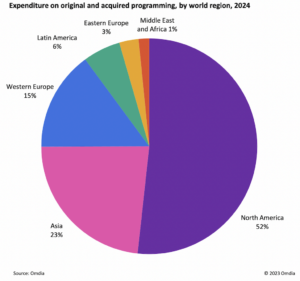TBI Tech & Analysis: Why 2024 will be a year of (modest) growth for the TV industry

Young Sheldon
Hollywood strikes, cutbacks in programming spend, and dire economic conditions are all overshadowing the worldwide TV programming business in 2023. However, the return to production in the US – the uncontested superpower in TV programming – will make 2024 a year of growth, write Omdia’s Tim Westcott and Matthew Evenson.
This growth may be modest, but channels and platforms still need high-quality programming, especially with the high level of competition in most markets.
The US studios will still be under pressure finally to bring their direct-to-consumer divisions into profit. As part of this effort, they will not only return to licensing their content to third parties, such as Warner Bros. Discovery has with shows such as Young Sheldon, but go back to more-traditional release patterns for new shows, partly because there will not be the expected volume of new programming.
Broadcasters will also look further into the future to a time when channels are distributed completely online. It will take some time to get there, but broadcasters and channels are already starting to prepare, with the aim of ensuring they have a prominent position on TV menus.
Free ad-supported streaming television (FAST) channels will continue their rollout outside the US, with FAST channel operators honing their FAST offerings, smart TV providers continuing to get more deeply involved in the market, and big players like broadcasters and pay-TV companies adding FAST channels as well.
Impacts & opportunitiesThe after-effects of the strikes will be felt throughout 2024 because the lack of new programmes coming through the pipeline will create gaps in schedules and online service offerings. The big US players, under pressure to cut costs, will be more open to co-productions. There will be opportunities for international players seeking funding from the US, which will account for more than half of all investment on original productions.
The TV industry is already preparing for a future where all channels are distributed digitally. It is going to be some way off – maybe 2030 – but the biggest broadcasters are already readying themselves and staking out their position on the consumer’s TV interface.
FAST was one of the trends of 2023 and will continue to be high profile in 2024. FAST is already well developed in the US but the rest of the world is catching up, with channel operators honing their FAST offerings and big players like broadcasters and pay-TV companies getting involved.
Meanwhile, consumers have already embraced one of the innovations of streamers: the all-at-once release model, which extended the binge-watching trend brought on by DVD boxsets. However, faced with mounting competition, streamers are increasingly going back to a linear model of staggered releases of episodes. The post-strike content shortage will only strengthen this trend.
The US studios are under pressure to show that their streaming services will be profitable. In addition to cutting costs and raising subscription prices, studio streamers are also looking for new, or in some cases old, windows and revenue opportunities. Many studios have now gone back to licensing content to third parties, instead of hosting their owned content exclusively on their own services.
The excerpt above comes from Omdia’s ‘2024 Trends to Watch: Digital Content & Channels’, by Tim Westcott, Senior Principal Analyst, Digital Content & Channels, and Matthew Evenson, Research Analyst, Media & Entertainment, which can be read in full here. Omdia and TBI are both part of Informa Tech.




